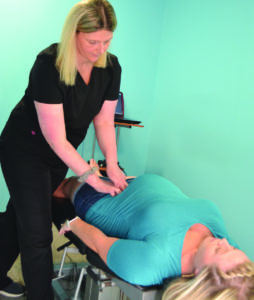
LEXINGTON Imagine a five-tiered wedding cake with all the trimmings. Then imagine that in between the layers of cake are layers of Jell-O. Then imagine as a surprise, the baker inserts a seven-pound, almond-shaped watermelon inside the cake layers. Finally, imagine turning the cake upside down and watching it walk down the aisle…in one piece!
Sounds kind of far-fetched, but a pregnant woman’s body undergoes a similar transformation during gestation when the spine, sacrum, and pelvic bone structures coordinate with the soft connective tissue, cartilage, tendons, and ligaments to become elastic from her hormone-induced secretions. The result is a walking balancing act that a woman carries off for nine months, hopefully culminating with a successful delivery.
We know that the labor process becomes complicated when the fetus is not in the optimal vertex presentation of posterior facing and head down in the labor canal. Typically, the baby will naturally turn into the correct position in advance, but according to the ACOG website, in approximately 3–4 percent of births, the baby doesn’t turn, and the result is what is commonly known as a “breech birth,” feet-first delivery.

The Webster Technique is an adjustment protocol used by chiropractors to help women stabilize their spine, sacrum, and pelvis during pregnancy, to have the optimal delivery experience and lessen the probability of a breech birth. The Webster Technique is a proprietary method of care developed by Larry Webster, DC, in the 1980s when he was inspired by his daughter’s difficult birth. The technique is based on Webster’s theory of “uterine constraint” which restricts movement of the baby in utero. With gentle adjustments of a women’s pelvis, spine, sacrum, and associated muscle groups, Webster observed that babies had more room and they turned head down, avoiding the breech birth.
In 2000, a certification program was initiated to teach the Webster Technique through the International Chiropractic Pediatric Association (ICPA). Tamera Tolson, DC, DACBSP®, proprietor of Back Talk Chiropractic, is certified in the Webster Technique, having completed the training in 2020. Tolson also holds a certification of Diplomate American Chiropractic Board of Sports Medicine. Back Talk Chiropractic recently moved to its new, expanded location on Liberty Road in Lexington to handle its increased patient volume.
A Full Service Practice
Back Talk Chiropractic is a full-service chiropractic practice serving Central Kentucky. Tolson also serves as the official chiropractor for the Lexington Legends baseball team. Tolson, a former Montgomery County High School athlete, was drawn to chiropractic medicine because of injuries she suffered playing basketball. Instead of shoulder surgery, she opted for rehabilitation and chiropractic adjustments with positive results. “I wanted to do for other athletes what my chiropractor had done for me,” she says.
Tolson received her undergraduate degree from Morehead State University and took her doctorate in chiropractic medicine at Palmer College of Chiropractic in Port Orange, Florida.
The Back Talk Chiropractic patient population is typically between 15 and 65 years old, with the common chiropractic presentations of neck and lower back pain from bulging and herniating discs. Additionally, because of her work with athletes, some of whom are teenagers, Tolson has an interest in extremity work such as shoulders, hips, feet, ankles, rotator cuffs, and plantar fasciitis.
Her common treatment plans are adjustments, stretching, E-stim (electrical stimulation) for constricted muscle groups, decompression, strength training, and dry needling for soft tissue trigger point release.
In recent years, some of her female athlete patients became pregnant and came to her for help with lower back pain. “A common misconception is that pregnant women can’t have spinal adjustments,” says Tolson. “That’s not true. We don’t twist and turn pregnant women, but they can have their spines adjusted to relieve pressure by using a different technique,” she states.
In an effort to better understand and assess her pregnant patients and to provide enhanced relief and care for the spinal compression their pregnancy brings on, Tolson pursued certification in the Webster Technique. The results have been rewarding for both Tolson and her patients.
Pregnancy changes a woman’s center of gravity, Tolson explains, and it puts tremendous pressure on the lumbar 5 spinal column joint, sacrum, plus the pelvis and pubic areas. Pain from spinal compression is compounded by the instability created by the muscle, tendon, and ligament laxity required in the abdominal and pelvic areas to make room for the baby. “The sacrum, the pelvis, the muscle groups, and the tendons all have to work together, contracting and expanding in preparation for delivery,” says Tolson.
The Webster Technique
A misconception about the Webster Technique is that it is used to turn the babies inside the mother into the preferred vertex position. Tolson clarifies that the purpose of the Webster Technique is to give the baby the room to move around. “It’s about helping the mother have the flexibility and strength in her pelvic joints and muscles to make room for the natural, internal movements of the baby. By correctly aligning and balancing the pelvis, the sacrum and muscle groups of the mom, the baby does the work of getting into the correct position,” says Tolson.
It’s more advantageous for the mother to start the Webster Technique early in the pregnancy, says Tolson, even coming in for an evaluation in the first trimester. Earlier in the pregnancy is better not only for assessment of the mother’s joint alignment, but also to maintain her joint stability and to relieve her lower back and pelvic pain.
Optimally Tolson like to see her patients a couple of times per week starting at the middle of the second trimester, around 20 weeks, until the mother’s spine is stabilized. Treatment is then tapered off according to the need of the patient and continues through the delivery. “Using the Webster Technique early and often lessens the chances of mal-presentation at delivery,” says Tolson.
As more women become aware of the benefits of chiropractic care during their pregnancy, Tolson predicts more women will seek it out. “Since I have my Webster Technique certification, I’m seeing many more referrals from midwives,” says Tolson.
Tolson’s philosophy of care is that “The body is designed to work and heal itself. It can do that when the nervous system is open and the bones are in alignment and the muscles are intact.




